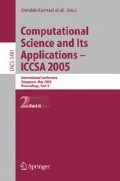Abstract
We present a model which enables us to study emergent principles of immune system T-cell repertoire self-organisation, based on a stochastic cellular automata model of a simplified lymphatic compartment. An extension of the immune system shape space formalism is developed such that each activated effector T-cell clonotype and viral epitope are represented as nodes, and edges between nodes models the affinity or clearance pressure applied to the antigen presenting cell bearing the target epitope. When the model is repeatedly exposed to infection by heterologous or mutating viruses, a distinct topology of the network space emerges which parallels recent biological experimental results in the area of cytotoxic T-cell activation, apoptosis, crossreactivity, and memory – especially with respect to repeated reinfection. The model presented here is a stochastic agent-based approach, which allows a broad distribution of results to be studied by tuning crucial T-cell life-cycle probabilities.
Access this chapter
Tax calculation will be finalised at checkout
Purchases are for personal use only
Preview
Unable to display preview. Download preview PDF.
References
Perelson, A.S., Oster, G.F.: Theoretical Studies of Clonal Selection: Minimal Antibody Repertoire Size and Reliability of Self-Non-Self Discrimination. J. Theor. Biol. 81(4), 645–670 (1979)
Smith, D., Forrest, S., Ackley, D., Perelson, A.: Using lazy evaluation to simulate realistic-size repertoires in models of the immune system. Bull. Math. Biol. 60(4), 647–658 (1998)
Brehm, M., Pinto, A., Daniels, K., Schneck, J., Welsh, R., Selin, L.: T cell immunodominance and maintenance of memory regulated by unexpectedly cross-reactive pathogens. Nat. Immunol. 3(7), 627–634 (2002)
Mason, D.: A very high level of crossreactivity is an essential feature of the T-cell receptor. Immunology Today 19(9), 395–404 (1998)
Borghans, J.A., De Boer, R.J.: Crossreactivity of the T-cell receptor. Immunology Today 19(9), 428–429 (1998)
Selin, L.K., Varga, S.M., Wong, I.C., Welsh, R.M.: Protective Heterologous Antiviral Immunity and Enhanced Immunopathogenesis Mediated by Memory T Cell Populations. J. Exp. Med. 188, 1705–1715 (1998)
Nowak, M.A., May, R.M.: 14. In: Virus Dynamics, pp. 149–181. Oxford Univ. Press, Oxford New York (2000)
Murali-Krishna, K., Lau, L.L., Sambhara, S., Lemonnier, F., Altman, J., Ahmed, R.: Persistence of Memory CD8 T Cells in MHC Class I-Deficient Mice. Science 286, 1377–1381 (1999)
De Boer, R.J., Oprea, M., Kaja, R.A., Murali-Krishna, Ahmed, R., Perelson, A.S.: Recruitment Times, Proliferation, and Apoptosis Rates during the CD8 + T-Cell Response to Lymphocytic Choriomeningitis Virus. J. Virol. 75(22), 10663–10669 (2001)
Badovinac, V.P., Porter, B.B., Harty, J.T.: CD8 + T cell contraction is controlled by early inflammation. Nat. Immunol. 5, 809–817 (2004)
Burns, J., Ruskin, H.J.: A stochastic model of the effector T cell lifecycle. In: Sloot, P.M.A., Chopard, B., Hoekstra, A.G. (eds.) ACRI 2004. LNCS, vol. 3305, pp. 454–463. Springer, Heidelberg (2004)
Burns, J., Ruskin, H.J.: Diversity Emergence and Dynamics During Primary Immune Response: A Shape Space, Physical Space Model. Theor. in Biosci. 123(2) (2004) 183–194
Burns, J., Ruskin, H.J.: Network topology in immune system shape space. In: Bubak, M., van Albada, G.D., Sloot, P.M.A., Dongarra, J. (eds.) ICCS 2004. LNCS, vol. 3038, pp. 1094–1101. Springer, Heidelberg (2004)
Grayson, J., Harrington, L., Lanier, J., Wherry, E., Ahmed, R.: Differential Sensitivity of Naive and Memory CD8 + T cells to Apoptosis in Vivo. J. Immunol. 169(7), 3760–3770 (2002)
Author information
Authors and Affiliations
Editor information
Editors and Affiliations
Rights and permissions
Copyright information
© 2005 Springer-Verlag Berlin Heidelberg
About this paper
Cite this paper
Ruskin, H.J., Burns, J. (2005). Network Emergence in Immune System Shape Space. In: Gervasi, O., et al. Computational Science and Its Applications – ICCSA 2005. ICCSA 2005. Lecture Notes in Computer Science, vol 3481. Springer, Berlin, Heidelberg. https://doi.org/10.1007/11424826_133
Download citation
DOI: https://doi.org/10.1007/11424826_133
Publisher Name: Springer, Berlin, Heidelberg
Print ISBN: 978-3-540-25861-2
Online ISBN: 978-3-540-32044-9
eBook Packages: Computer ScienceComputer Science (R0)

